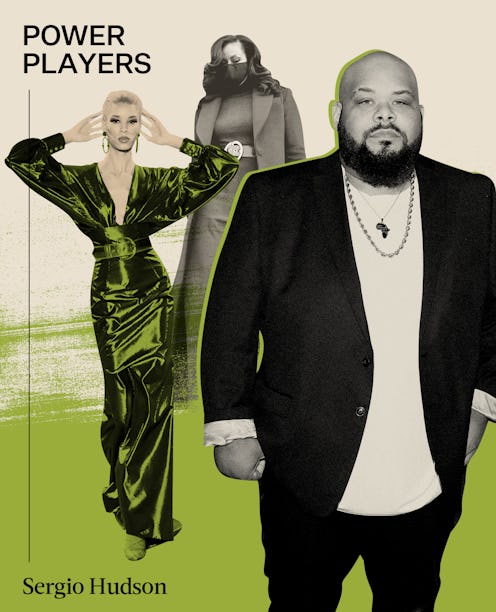Power Players
Sergio Hudson Wants To Normalize Black Designers Running Legacy Brands
“My hope for fashion is that it would flourish and become really inclusive.”

In “Power Players,” change makers in the fashion industry tell Bustle how they’re pushing boundaries and moving the culture forward, whether they’re advocating for sustainability, bringing more inclusivity to the runway, or making strides in technology and innovation. Here, Sergio Hudson discusses the importance of representation in fashion design.
Sergio Hudson remembers exactly where he was when he saw Michelle Obama arrive at the 2021 inauguration wearing his design, a custom oxblood palazzo pantsuit with a matching overcoat and a belt with his signature oversize buckle.
“I got off the plane [from D.C.] and went into the lounge to see the inauguration,” the 36-year-old designer tells Bustle. “I saw Michelle Obama coming down the stairs at the same time as everybody else. It was the moment my career changed. I physically felt it. Because I was in the room and people audibly gasped.”
Hudson has been a fixture in fashion since he launched his namesake ready-to-wear collection in 2014. The inauguration, however, gave him his biggest platform to date, and the opportunity to dress both the former first lady and Vice President Kamala Harris.
Dressing politicians is “definitely different” from working with celebrity clients, Hudson says. “Especially working with the vice president’s team. Her style is secondary to what she does. She is not a first lady. She is an elected official. And she’s in a position where she’s the first [woman] to do this. They’re trying to figure out, ‘OK, how far do we go? What should she wear? What shouldn’t she wear?’”
For the inauguration, Hudson created an all-black design for Harris, which was originally supposed to be a gown and opera coat. But when the inaugural ball was canceled due to the insurrection, Hudson had to make eleventh-hour changes.
“We changed the opera coat to just a tuxedo overcoat,” he says. “And they cut the gown to a cocktail dress to make it not so evening.”
Just a few weeks after the inauguration, Hudson sat down with Bustle and he shared how he’s using his newfound influence to shake up the fashion industry.
You’ve always prioritized inclusivity through your brand. Why is that important to you?
It should be normal when you see a designer and they’re Black. It’s not normal for a former first lady to be that fabulous and to be Black. It’s not normal for a Black woman to be the vice president.
How would you assess the state of diversity and inclusion in fashion?
American fashion has made tremendous strides, even over the last six months. To go into a meeting with a department store and for them to say, ‘OK, we’re adding this many designers of African descent to our store,’ it’s like, ‘Wow, like you really are trying.’ There’s still a ways to go.
Who do you think holds the power in fashion right now?
Growing up, it was always the editor who held the power. But now celebrity stylists can make or break a career. Think about what happened with me — because I dress Michelle Obama, editors are coming to me to see what else I have. The buyers are coming because customers are asking, ‘Where are these clothes? Why are they not in your store?’ I see the celebrity stylist as holding pretty much all the cards at this point.
How do you define power? What does power look like to you?
Power is influence. If we relate it back to fashion, my great mentor in my head is Gianni Versace, who I molded my career after. He had power because the masses looked for what he was going to do next. They believed in what he did, to the point where if [he] got a bad review, people would go after the reviewer. That was real power and influence.
What have been some of the most valuable lessons you’ve learned working in fashion?
Do the work, and be good at what you do. You have to meet the moment. For me, it is the quality my clothing has. I can get in the door because I was on J. Lo. But once you see my clothes in person, then you’re like, ‘Wow, these are really nice.’ Make sure everything out there with your name on it is the best it can be.
How do you deal with negativity and not letting outside distractions interfere with your progress?
I completely ignore negativity. I’m trying to build a legacy brand as an African American from Ridgeway, South Carolina, with working-class parents. I’m trying to do something that has never been done before. I can’t afford to allow negativity to creep in.
What are your hopes for the future of fashion and for you and your brand?
My hope for fashion is that it would flourish and become really inclusive. For me personally, I want this brand to be bigger than anything — not just for me, but to be a light to the next young boy growing up in South Carolina who has dreams of being a designer. That he can see it’s easier, because this Black boy from South Carolina already did it.
This interview has been edited and condensed.